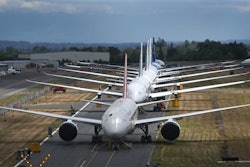Imagine that a new type of airplane is supposed to be in commercial flight starting this year, but the engine for the plane will not be ready in time. Or, the onboard avionics electrical system has software bugs that still need fixing and will be delayed. Or, the timing on delivery of the airplane wings has been miscommunicated. The manufacturer thought it was going to arrive in time to be installed, so the plane would be ready to go this year, but the wing maker thought the delivery date was some other time.
These types of scenarios are causing major challenges throughout the aerospace and defense industry. Products are usually delivered late to market. The quality and efficiency of information sharing among various suppliers has been unacceptable. Widespread collaboration doesn’t exist. Independent business remains the norm. Yet the industry — like so many others — has become so interdependent that what affects one group affects several others.
A coordinated system of collaboration that would make this system work more smoothly remains elusive. These challenges have resulted in several well-publicized delays in deliveries of major aerospace and defense programs to market, costing the industry in revenues and credibility.
Considering this state of the industry, fundamental systemic changes are needed now. A shift to a new and collaborative business model, known as the “extended enterprise,” should be one such change.
Accenture defines the extended enterprise as a network of firms, ranging from customers to suppliers and third parties. These companies collaborate to design, develop, produce, deliver and support a product. The extended enterprise encompasses all facets of collaboration such as processes, people and technologies needed to efficiently manage network interdependencies. At its core, an extended enterprise is intended to improve operational efficiency and potential revenue growth, strengthen relationships with customers and suppliers, and accelerate product deliveries.
My colleagues at Accenture recently interviewed a select group of industry executives about how and why the extended enterprise movement is already starting to transform the industry. The executives based in eight countries — Brazil, Canada, France, Germany, Italy, Spain, the United Kingdom and the United States — work for the largest manufacturers of aircrafts, aircraft engines and components in engineering, service and support operations, and procurement. A summary of the findings and analysis can be found in a new report titled “Defining the Extended Enterprise.”
Key findings
Although these executives cited numerous potential barriers to making such models operate effectively, they acknowledged the urgent need to pursue extended enterprise opportunities. Most have started such initiatives in the past year or two. To remain competitive, they understand they have to invest and focus more on building and participating in extended enterprise business models. But they said it is going to be a complicated and difficult challenge.
Multiple benefits are possible
According to the report, interviewees shared what they believe to be numerous extended enterprise benefits such as:
- increasing efficiency and reducing costs;
- stabilizing the supply chain;
- facilitating control of key information;
- gaining new capabilities;
- leveraging innovative technologies;
- mitigating financial and commercial risks;
- managing resources and skills;
- strengthening relationships with customers and suppliers;
- improving consistency and coherence across enterprise groups; and,
- leveraging deeper and more updated experience about international trade regulations.
Multiple challenges
Counterbalancing these benefits, the executives indicated they grapple with challenges ranging from cost pressures to scarcity of talent, to more viable competitors in emerging economies. They realize they have to ease pressures between familiar and new ways of working such as security versus openness; intellectual property protection versus shared innovation; and pooling of skills versus fierce competition for talent. Balancing all this effectively to create a high performance extended enterprise requires a major departure, new thinking and different behavior. Interviewees told us they are finding it difficult to structure their specific extended enterprise objectives within a collaborative context to gain business and operational benefits.
Gap between theory and practice
In pursuit of pervasive industry collaboration, our interviews uncovered the gap between theory and practice. Although respondents acknowledged the importance of collaboration with shared objectives and a common organization, few have progressed to practical steps and delivering broader relationships to achieve this. Concerns prevail about appropriate collaborative levels of collaboration and definitions of roles.
Interviewees expressed concern about how to define the right extended enterprise performance indicators, develop common standards and comply with regulations. Confidentiality and data security are of particular importance. These two factors create tension between demands of openness and transparency and the need to protect intellectual property and data.
These interviews revealed that companies are exchanging talents and skills. But the more strategic approaches tend to be restricted to larger suppliers and integrators sharing talent more willingly, especially to address complex work. Significant tension exists regarding the need to retain competitive advantage versus requirements to add skills to drive innovation and adapt to changing customer requirements. Achieving this balance is difficult. While aerospace and defense companies recognize that exchanging personnel delivers major benefits, among them are lower costs and increased profitability for both parties, they remain wary of undermining their sources of competitive advantage.
Key factors that will drive growth
As a result of this work, we have identified and defined five building blocks to an extended enterprise organization:
- Collaboration and governance: working together to achieve a common goal with mutual understanding of needs and objectives; developing team-oriented or contractual relationships depending on closeness of collaboration.
- Talent and competencies: developing and sharing skills and competencies needed across the extended enterprise for mutual benefits while managing and retaining the best talents for competitive advantage.
- Agile operations: the ability to flex and adapt to changing needs across the extended enterprise; defined in terms of agility in new or existing relationships as well as adapting to changes across the ecosystem that impact processes or product deliveries.
- Data sensitivity and regulations: ability to execute business in compliance with aviation authorities’ rules, legal and contractual requirements, and government requirements; and to demonstrate at any time conformity the responsiveness of the extended enterprise to those requirements.
- Innovation: the ability to capture and integrate innovations across suppliers and technology collaborators, creating barriers to competition while maintaining control of the company’s intellectual property.
Of these five, allow me to delve deeper into two of particular note: collaboration and governance, and talent and competencies.
Collaboration and governance
Governance embodies one of the fundamental building block of the extended enterprise. The effectiveness of such an enterprise rests on the foundation of trust. Trust requires transparency. In this highly competitive industry, however, trust is elusive. Any omissions or allowances made in the information provided between collaborators will cascade through the entire ecosystem with the likely result the extended enterprise model will not work. For this business model to flourish, aerospace and defense companies would need a common vision of objectives, the roles of each party involved, decision-making processes, a common framework, IT governance and security rules.
If all members of the extended enterprise, for example, build an unstated contingency for their own delivery schedules, a program probably won’t deliver on time. To avoid this, corporate cultures need to profoundly shift. An authentic extended enterprise consists of an interdependent network of organizations in which no single organization has ultimate operational control. Governance needs to encompass all parties involved ranging from multiple suppliers to clients. These extended enterprises need to operate as a single virtual entity while maintaining their independence. Because each relies on the others and information they provide, the fundamental ingredient for success boils down to trust.
Talent and competencies
Talent remains in short supply in this industry. Strict regulations limit the extent to which talent can be easily imported from elsewhere. Maintaining intellectual property and assets, especially in the defense market, inhibits talent strategies that could be executed in a more open market. Talent scarcity drives more intense industry competition and raises a particular challenge for the talent pool available to small and medium-sized companies, which are essential to an extended enterprise operating effectively.
Aerospace and defense companies need to have the right people to operate with a mentality of taking risks. Developing local talent in the ecosystem has become more important. Building talent across the extended enterprise is critical. This requires that organizations sponsor relevant university faculties as well as share resources across the enterprise to drive teamwork and trust.
Final thoughts
Developing a high performance extended enterprise depends on the ability to share skills, experience and knowledge throughout the network, and this sharing has to benefit the entire network rather than isolated groups. There must also be trust, which is a long-term process dependent on intangible factors. Trust is precarious because it can be destroyed quickly.
The goal of the extended enterprise is to be organized in a way that intends to benefit all stakeholders. The model should be project or program oriented whereby companies will join forces and be organized in a network structure to develop, for instance, an aircraft or engine. Because of confidentiality and competition, the model cannot work otherwise.
There is no turning away from the extended enterprise momentum. Companies need to face it and embrace it to achieve high performance.
Damien Lasou is the global managing director of Accenture’s aerospace and defense practice. He can be reached at [email protected].























